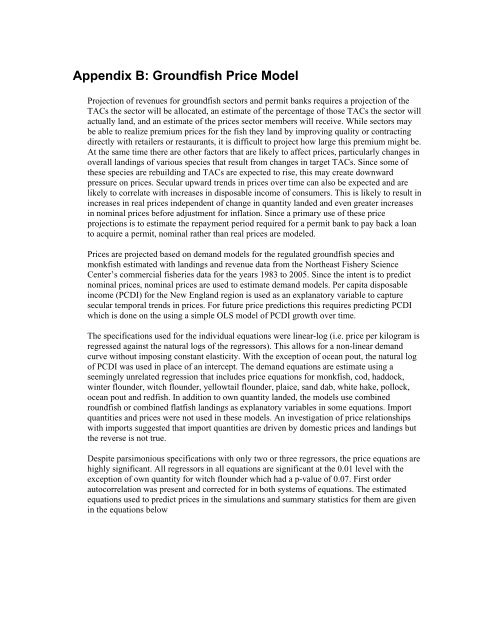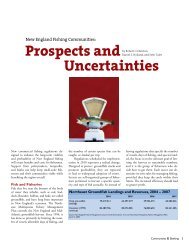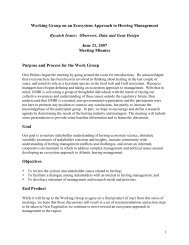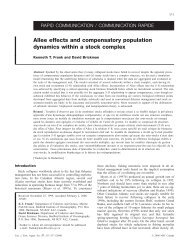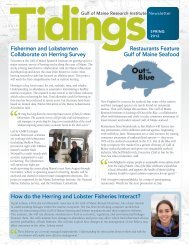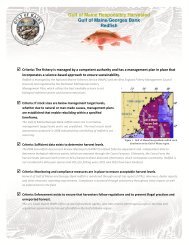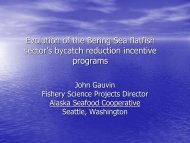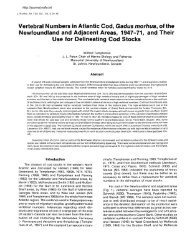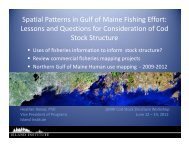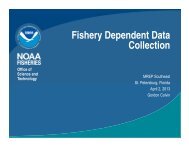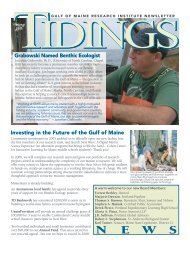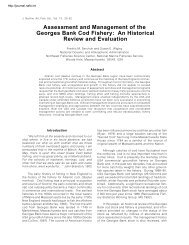Community-based Sectors for the New England Groundfish Fishery
Community-based Sectors for the New England Groundfish Fishery
Community-based Sectors for the New England Groundfish Fishery
Create successful ePaper yourself
Turn your PDF publications into a flip-book with our unique Google optimized e-Paper software.
Appendix B: <strong>Groundfish</strong> Price Model<br />
Projection of revenues <strong>for</strong> groundfish sectors and permit banks requires a projection of <strong>the</strong><br />
TACs <strong>the</strong> sector will be allocated, an estimate of <strong>the</strong> percentage of those TACs <strong>the</strong> sector will<br />
actually land, and an estimate of <strong>the</strong> prices sector members will receive. While sectors may<br />
be able to realize premium prices <strong>for</strong> <strong>the</strong> fish <strong>the</strong>y land by improving quality or contracting<br />
directly with retailers or restaurants, it is difficult to project how large this premium might be.<br />
At <strong>the</strong> same time <strong>the</strong>re are o<strong>the</strong>r factors that are likely to affect prices, particularly changes in<br />
overall landings of various species that result from changes in target TACs. Since some of<br />
<strong>the</strong>se species are rebuilding and TACs are expected to rise, this may create downward<br />
pressure on prices. Secular upward trends in prices over time can also be expected and are<br />
likely to correlate with increases in disposable income of consumers. This is likely to result in<br />
increases in real prices independent of change in quantity landed and even greater increases<br />
in nominal prices be<strong>for</strong>e adjustment <strong>for</strong> inflation. Since a primary use of <strong>the</strong>se price<br />
projections is to estimate <strong>the</strong> repayment period required <strong>for</strong> a permit bank to pay back a loan<br />
to acquire a permit, nominal ra<strong>the</strong>r than real prices are modeled.<br />
Prices are projected <strong>based</strong> on demand models <strong>for</strong> <strong>the</strong> regulated groundfish species and<br />
monkfish estimated with landings and revenue data from <strong>the</strong> Nor<strong>the</strong>ast <strong>Fishery</strong> Science<br />
Center’s commercial fisheries data <strong>for</strong> <strong>the</strong> years 1983 to 2005. Since <strong>the</strong> intent is to predict<br />
nominal prices, nominal prices are used to estimate demand models. Per capita disposable<br />
income (PCDI) <strong>for</strong> <strong>the</strong> <strong>New</strong> <strong>England</strong> region is used as an explanatory variable to capture<br />
secular temporal trends in prices. For future price predictions this requires predicting PCDI<br />
which is done on <strong>the</strong> using a simple OLS model of PCDI growth over time.<br />
The specifications used <strong>for</strong> <strong>the</strong> individual equations were linear-log (i.e. price per kilogram is<br />
regressed against <strong>the</strong> natural logs of <strong>the</strong> regressors). This allows <strong>for</strong> a non-linear demand<br />
curve without imposing constant elasticity. With <strong>the</strong> exception of ocean pout, <strong>the</strong> natural log<br />
of PCDI was used in place of an intercept. The demand equations are estimate using a<br />
seemingly unrelated regression that includes price equations <strong>for</strong> monkfish, cod, haddock,<br />
winter flounder, witch flounder, yellowtail flounder, plaice, sand dab, white hake, pollock,<br />
ocean pout and redfish. In addition to own quantity landed, <strong>the</strong> models use combined<br />
roundfish or combined flatfish landings as explanatory variables in some equations. Import<br />
quantities and prices were not used in <strong>the</strong>se models. An investigation of price relationships<br />
with imports suggested that import quantities are driven by domestic prices and landings but<br />
<strong>the</strong> reverse is not true.<br />
Despite parsimonious specifications with only two or three regressors, <strong>the</strong> price equations are<br />
highly significant. All regressors in all equations are significant at <strong>the</strong> 0.01 level with <strong>the</strong><br />
exception of own quantity <strong>for</strong> witch flounder which had a p-value of 0.07. First order<br />
autocorrelation was present and corrected <strong>for</strong> in both systems of equations. The estimated<br />
equations used to predict prices in <strong>the</strong> simulations and summary statistics <strong>for</strong> <strong>the</strong>m are given<br />
in <strong>the</strong> equations below


